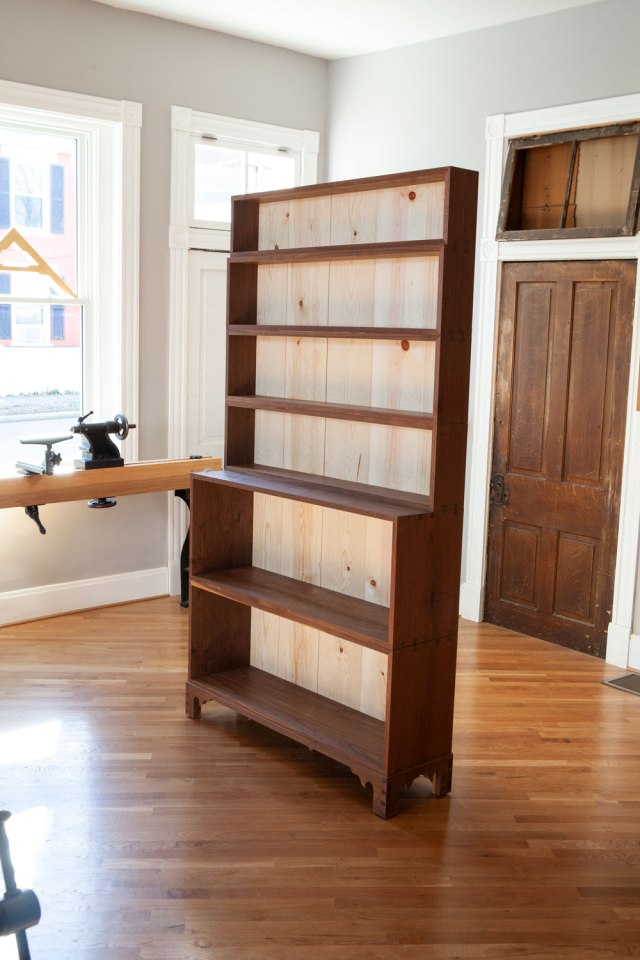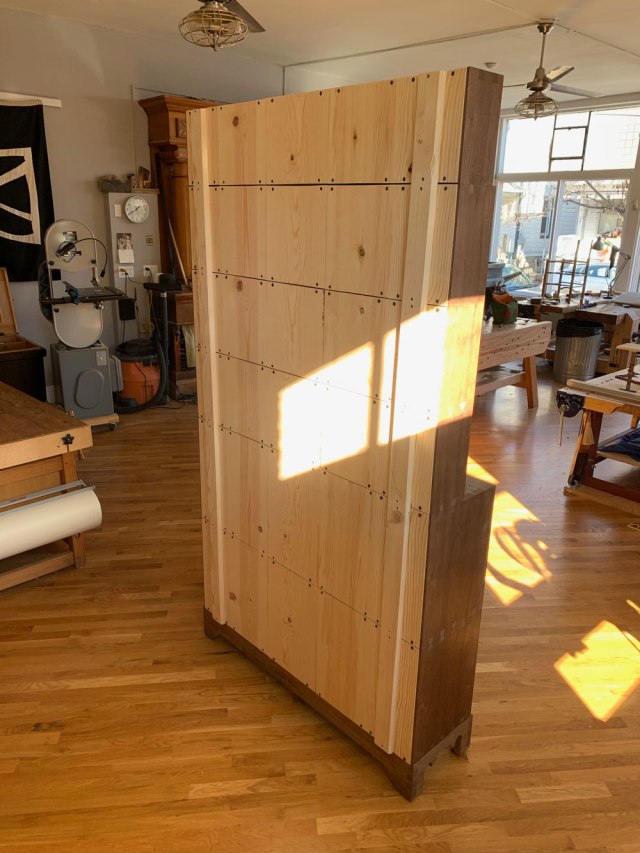
These bookcases are similar to a set I built for the June 2011 issue of Popular Woodworking Magazine, which has the complete plans with step photos and instruction. You can download a free SketchUp model of the bookcase here.
The Story Behind the Shelves
I’m allowed to quote myself, right? Here, then, is the backstory on these shelves. Read it before I issue myself a cease-and-desist letter.
I like to think of Thomas Jefferson’s personal library as America’s first “Bookmobile.”
When the British burned down the nation’s capitol in 1814, the inferno took with it many of the books owned by the government of our young nation. Lucky for us, Jefferson had a personal library of about 6,700 books – an astonishing accomplishment for the time.
And after some negotiations, Jefferson agreed to cede his entire library at Monticello to Congress for the sum of $23,950. The question was, how to transport 6,700 books from Virginia north to Washington, D.C., with horse-drawn wagons.
Lucky for us, Jefferson was a clever man. He stored his precious library in pine boxes that were designed specifically to travel. While it isn’t known if Jefferson designed the book boxes (or “book presses” as they are sometimes called), they do bear the mark of his cleverness.
For when the day came to transport this massive chunk of knowledge, the process was straightforward. Scrap paper was stuffed among the books to protect them, then a lid was nailed over the front of each unit and it was loaded onto a wagon and carted to Washington.
Jefferson’s collection of books (which continues to make headlines even today) was the foundation for our Library of Congress. His method for organizing his books (memory, reason and imagination) pushed us into a more modern classification system. Until that time it was common to organize books by height or color.
But What About the Boxes?
While a good deal is known about the books in Jefferson’s collection that he sold to Congress, far less is known about the stackable boxes that he used to store his library at Monticello. By examining the written records, officials at Monticello built six bookcases for the museum in 1959 that are a good guess at what would have housed Jefferson’s library (though he could have had as many as 20 of these units, if you do the math).
Since the day I started woodworking, I have been concerned about amassing information on the craft. For me, the written word enhances my personal experience in the shop, and it is a way to stay in touch with the craft while I am on the road, in bed or sitting on the couch.
As my library got out of hand sometime about 2005, I decided I needed to build something to store all my woodworking books. I also wanted something that would allow them to be easily transported when my wife and I leave our house after the kids are off to college, and we launch the next phase of our lives.
And so I became interested in Jefferson’s book boxes. I read the original letters that describe how the books were transported. I used the standard measurements for books of the day to help fill in the blanks when it came to designing the three different case sizes Jefferson describes in his correspondence.
Oh, and what was the joinery on these boxes? Who knows. Perhaps the boxes were nailed together, as there were as many as 150 individual book boxes to hold the nearly 6,700 books.
But I prefer to think that our third president, who was familiar with the principles of joinery, would insist on something more substantial. And so, despite the fact that no surviving examples of these book boxes exist, I built each of these units using through-dovetails with mitered shoulders at the corners. (Here’s a video showing how to do it.) The backs are shiplapped and nailed on to the carcases.
This approach to building a box is typical for the time, and I bet that my modern book boxes would easily survive a wagon journey from Monticello to Washington, D.C.

About This Set of Bookshelves
As I’ve gotten older, I’ve become more OCD (apologies to poor Brendan and Megan, who suffer my wrath when the shop’s coffee mugs are unwashed). So when faced with making a new set of these shelves, I decided to ratchet up the insanity.
At the customer’s request, all the visible boards are full-width (I hid a couple glue-ups and buried the seams below the tailboards). At my stupid brain’s request, I made the ends of the cases all one single board with the grain matched all the way up the 7’2” case. It took months (and cash) to find the right 14”-wide walnut boards.
To make it harder, I made the dovetails line up all the way up the case sides, a detail I cribbed from Jameel Abraham when he built his version of these bookcases.
Then, because that wasn’t hard enough, I made the backboards match all the way up the case. Yesterday I juggled 30 pine backboards that had to all line up or it would look like crap. Also, the way I staggered the widths of the backboards was a math equation. Let’s just agree that I made this harder than it should be.
The bookshelves are finished with shellac. The backboards are finished with two coats of super blonde shellac. The cases and plinth are finished with three coats of garnet shellac.
And now I just have to build the crate. This sucker has to go on a truck bound for Michigan at 8 a.m. Friday. This weekend, I’ll take it easy and complete a couple small projects for a customer in California. Then, on Monday, I start the most difficult and involved project so far (besides my kids). It’s a massive three-tiered campaign chest with three transit cases that store the disassembled chest components and then stack as a wardrobe.
— Christopher Schwarz